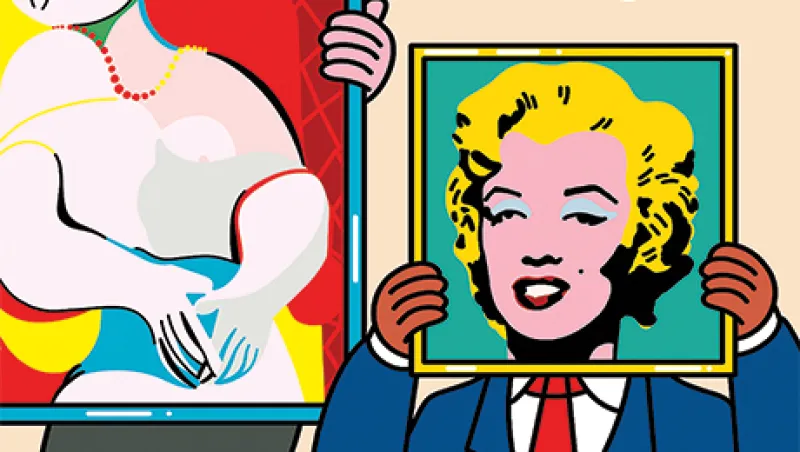Only about two dozen paintings in the world are known to have sold for more than $100 million each. Of those, at least seven were purchased by men who made their fortunes in asset management.
The most expensive acquisition may be one made by Ken Griffin, founder and chief executive officer of alternative investment manager Citadel. In September 2015, the then–46-year-old hedge fund billionaire paid $500 million for two abstract expressionist works: Interchange, by Willem de Kooning, and Number 17A, by Jackson Pollock, according to The New York Times. The de Kooning piece, bought for about $300 million, is widely regarded as the priciest painting ever sold — or is, at the very least, tied for first with the post-impressionist “When Will You Marry?” by Paul Gauguin, according to the Guinness World Records.
These aren’t the first artworks for which Griffin has shelled out tens of millions: In 2006, he spent $80 million on False Start, a colorful oil painting by Jasper Johns, said a New York Times report at the time. Seven years earlier, he had bought the Paul Cézanne still life Curtain, Jug and Fruit Bowl for $60.5 million, Chicago magazine said in a 2005 profile of the billionaire.
At the same time Griffin was purchasing his Jasper Johns, hedge fund peer Steve Cohen — then still operating as chief executive of SAC Capital Advisors — spent $63.5 million on a de Kooning painting of his own, the abstract landscape Police Gazette, reported The New York Times. Cohen, whose full art collection was estimated last fall by Forbes to be worth $1 billion, has also bought such pieces as Andy Warhol’s Turquoise Marilyn ($80 million), a Johns work called Flag ($110 million), and another de Kooning titled Woman III ($137.5 million), according to The New York Times. His most expensive purchase, the $155 million acquisition of Pablo Picasso’s Le Rêve, was announced in March 2013, less than two weeks after SAC paid $616 million to settle insider trading charges, the paper reported.
Griffin and Cohen are the highest-spending on a long list of money managers who have directed their masses of wealth toward this high-end hobby.
Third Point CEO Dan Loeb, for example, has been known to turn a quick profit in art, famously selling one of his many Martin Kippenberger paintings in 2005 at a 500 percent markup, making $1 million within two years of his purchase, according to The Wall Street Journal. Another high-profile collector, Tiger Management founder Julian Robertson, donated a $115 million, 15-piece collection of works by modern artists including Henri Matisse and Salvador Dali to the Auckland Art Gallery in New Zealand, The New Zealand Herald reported in 2009. And in 2012, Apollo Global Management CEO Leon Black paid almost $120 million at a Sotheby’s auction for a pastel rendering of Edvard Munch’s iconic masterpiece The Scream.
“At the highest end of the market, there is a level of wealth required to participate,” says Brook Hazelton, Americas president for international auction house Christie’s. “Relatively young hedge fund managers are able to get into art in a big a way.”
The fierce competition among Wall Street billionaires for what is often known as “wall power” has contributed to a dramatic escalation in art prices over the past few decades. Griffin’s False Start, for example, has more than quadrupled in value in the past 20 years: The New York Times reported in 1988 that the Jasper Johns painting had sold for $17 million, at the time the second-highest price ever paid at an auction in the U.S.
Most of the artworks being bought and sold at the highest end of the spectrum skew contemporary, if only because antiquities and old masters are in low supply on the market — the very best are held by museums that aren’t selling, Hazelton explains. A number of factors can drive up a painting’s value — ranging from the reputation of the artist to the fame of its previous owners — but very few works surpass the $50 million price point, he adds.
“There’s certainly a pride of possession that accompanies art ownership at this level,” Hazelton says. “There’s certainly a status symbol element — in some cases that’s a very important factor for buyers at the highest price point.”
For asset managers, art collecting can even be seen as an extension of their day jobs — another market in which to display their skill in identifying undervalued assets. But though Hazelton says it is typical for buyers to view high-end artworks as an investment, most purchasers employ a “buy-and-hold” mentality.
“It’s not the case that they are buying with the intent of selling — it’s not even a good idea from the perspective of good investing,” he says. “One of the factors that drives up value is freshness to market, so when things are bought and sold in rapid succession, it hurts the market value of the piece.”







